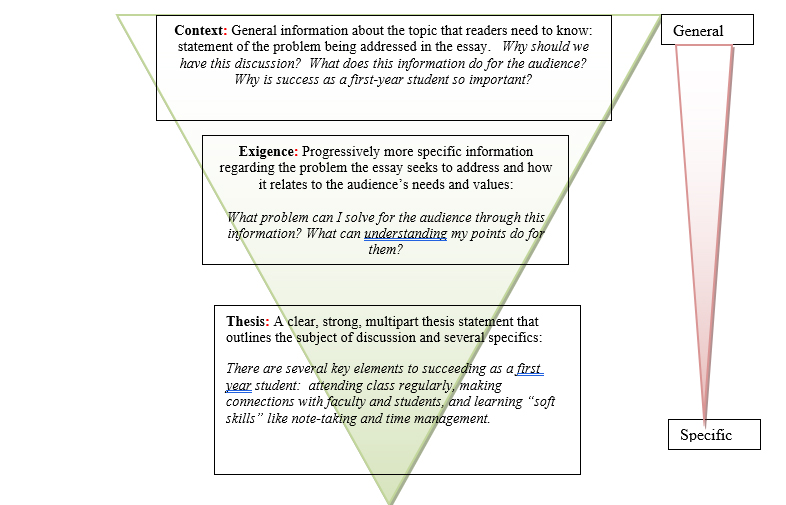Composition 03b: Organizing Expository Essays
Organizing Expository Essays
Most expository writing is not primarily narrative-based (though narratives are often used as evidence / examples in this mode), so a timeline / chronology as an organizing principle would not be appropriate. As expository writing seeks to inform or explain—and often draw conclusions—having a good idea of what you plan to explore is paramount. A clear thesis that articulates some specifics of what the essay will be discussing will accomplish this, and enable you to build a coherent essay that supports your overall aim in the work.
Multipart Structure: A Convenient Expository Template
One of the most popular organizational schemes for basic expository essays is Multipart Structure. This is, as one might expect, a method of organization that divides the discussion into several distinct but related parts. You might have heard of or even used this essay structure before; some high schools teach this as the “five paragraph essay” or the “five-part theme.”
Nothing, however, requires that an essay have five parts. A multipart structure could be built around one or two ideas (for shorter discussions) to many linked ideas (for longer, more complicated discussions).
The key idea here is to use a good, detailed thesis statement—often with solidly articulated points laid out in the statement itself—to provide structure and a “blueprint” for your essay.
Here’s a simple diagram of a multipart essay, here with three body sections.
-
Introduction
-
Body Section I
-
Body Section II
-
Body Section III
-
Conclusion
This organizational approach allows the writer to accomplish three primary tasks in the discussion: introducing the topic and the writing’s objective, developing assertions and evidence, and concluding / restating the writing’s purpose.
The Introduction in an expository essay accomplishes three main things: it introduces the topic and provides essential background for the reader, it outlines the argument’s thesis statement or controlling idea, and it establishes a sense of the writing’s exigence or urgency—a sense of importance , relevance, and timeliness—for the reader. The thesis statement in a multipart essay is often a multipart thesis (see Chapter 05.3.1, Thesis Statements, for more information on constructing a good thesis). For more information on writing introductions, see Chapter 05.3.3, Introductions and Conclusions.
Body sections are often organized in a similar general-to-specific manner as an introduction paragraph, but with the body paragraph beginning with a topic sentence that relates directly to part of the thesis statement: one of the “three parts” of the three-part thesis.
The essay’s conclusion is a way to not only sum up or restate what was said in the body of the essay (again as it relates to the essay’s thesis statement), but also a way to reinforce the sense of exigence or “so what” for the reader.
For purposes of this discussion, we’ll use the following multipart thesis as an example:
There are several key elements to succeeding as a first year student: attending class regularly, making connections with faculty and students, and learning “soft skills” like note-taking and time management.
Introductions usually start with relatively general information about the problem, situation, or debate that the argument essay is addressing, and build toward more narrow and specific information, ending with the essay’s thesis. So the basic organization of an argumentative introduction looks something like this:

The three body sections in a multipart essay each address and develop an element of the essay’s overall topic, as it is introduced in the introduction’s thesis statement. As this multipart thesis has three parts, each part of the thesis must be addressed in its own section of the essay’s body.
We refer here to body sections rather than body “paragraphs” to allow for the possibility that an idea or part of an essay’s thesis might require more than a single paragraph to develop adequately. Body sections contain clarifications of the ideas and the evidence of the essay, and are often dependent on clear explanations, examples, and other specific details that support the essay’s thesis.
